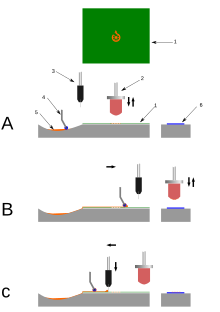Pad printing

The tampon printing is an indirect gravure printing process , in which the ink is transferred by an elastic pad made of silicone rubber of the printing form to the printing substrate. The color is transferred to the material by pressing it in different thicknesses. The pad printing process is the most important process for printing plastic objects and is therefore of great importance in the advertising industry, among other things. It emerged from the decalcation process when, in 1968, the master engraver Wilfried Philipp replaced the unstable gelatin tampons of this process with those made of silicone rubber.
Printing process
The print image that is to be transferred is exposed to a cliché using a positive film (offset film) or also called matt film . A distinction is made between steel clichés and plastic clichés. With steel plates, the print image is etched into the steel surface. Steel clichés are used for recurring print images with very high quantities. This cliché is washed out after exposure. As a result, the exposed print image remains deepened on the surface of the cliché. The preparation for printing is now complete.
After the cliché has been mounted on the machine, the mechanical process of printing takes place. The printing ink is moved back and forth with the help of a squeegee made of metal or plastic (in earlier years roller or brush) and washed over the cliché with ink. When moving backwards, a knife pulls the paint off again and leaves it behind in the recess. The pad then rests on this printing form, lifts off again, taking the printing ink with it, and moves to the printing material. There the pad lowers, adapts to the shape and leaves the color (the print image) on the print material. In the case of multi-color printing, this color sequence is repeated in a second pass with a different color.
The advantage of this transfer of pressure is the deformability of the pad, which makes it possible to print on curved surfaces ( convex , concave or grained). Due to its elasticity, the tampon takes on the shape of the body to be printed and can thus ideally transfer the motif onto the printing material. The print image is transferred to the print body. The ink transfer to the printing material is almost 100% due to the silicone oil in the pad. In addition, different sizes can be printed in different colors.
application

Due to its adaptability, pad printing can be used when printing on surfaces with a relatively complex shape. Areas of application are, for example, the printing of syringes, toys, CDs, dishes, screw caps, medical products, aircraft and vehicle interior parts, lighters, tin cans and coins. The surface material plays a rather subordinate role. The print can be easily applied to plastic, rubber, glass, ceramics, paper, wood, metal and many other materials.
In the automotive sector, many parts are decorated using pad printing, such as the indicator or windshield wiper lever.
This printing technique is used particularly often in the advertising industry and model railways , as many promotional items and rail vehicle models do not have a flat surface.
Machine technology
The mechanical structure of the inking system distinguishes between three basic types:
- Open color system
- from approx. 1971, the paint lies in an open paint basin, is brushed over the printing cliché with the paint spatula , and the excess paint is wiped off with the doctor blade. One advantage of this system is given with large printing areas. This inking system is considered obsolete for small print areas.
- Closed color system
- from approx. 1983, paint is in a hermetically sealed paint pot, which at the same time contains the squeegee element through a circumferential squeegee ring made of hard metal or ceramic and squeegees off the excess paint.
- The doctor ring is also the sealing element. The pot is pressed against the cliché so that there is no undesired paint leakage. With some machines this is done by magnets, with others by adjustable spring preload or pneumatic pressure.
- Rotary pad printing
- from approx. 1981, for printing round parts or for continuous printing. Both the tampon and the cliché are designed as rollers and thus allow a continuous sequence of movements. The paint lies in an open paint basin. Application e.g. B. in systems for printing bottle caps or plastic profiles.
With some pad printing machines, the movements are pneumatic, with others, especially fast machines, electromechanical via cams. The latest generation of pad printing machines is driven by linear motors, which guarantees a programmable workflow. A wide variety of print images can be issued via automated part recognition without having to change the cliché.
High-quality machines usually have an automatic device for cleaning the tampon (tampon cleaning, residual ink collection) and automatic ink thinning. Machines for integration into automations are appropriately equipped with PLC controls and suitable interfaces.
literature
- Rudolf Bührer: Book for pad printing , 2nd edition, Der Siebdruck, Lübeck 1990, ISBN 3-925402-22-5 .
- Siegfried Meyer: Pad Printing: Processes and Possibilities. Der Siebdruck, Lübeck 1994, ISBN 3-925402-67-5 .
- Hans Jürgen Scheper: Examination knowledge printing technology. Profession and School, Itzehoe 2005, ISBN 3-88013-623-8 .
- " Pad printing ", Microprint LC GmbH, (pdf, 92 pages)
Web links
Individual evidence
- ↑ Müller, Klaus-Peter .: Practical surface technology: pretreatment - coating - coating defects - environmental protection; with 72 tables . 4th, revised. Ed. Vieweg, Braunschweig 2003, ISBN 3-528-36562-5 ( worldcat.org [accessed July 29, 2019]).
- ↑ Völker Industrie Drucke: What is pad printing? In: https://voelker-druck.de/technik/ . Peoples Industry Prints, accessed July 29, 2019 .
- ↑ Pad printing on various materials. Retrieved May 28, 2019 .